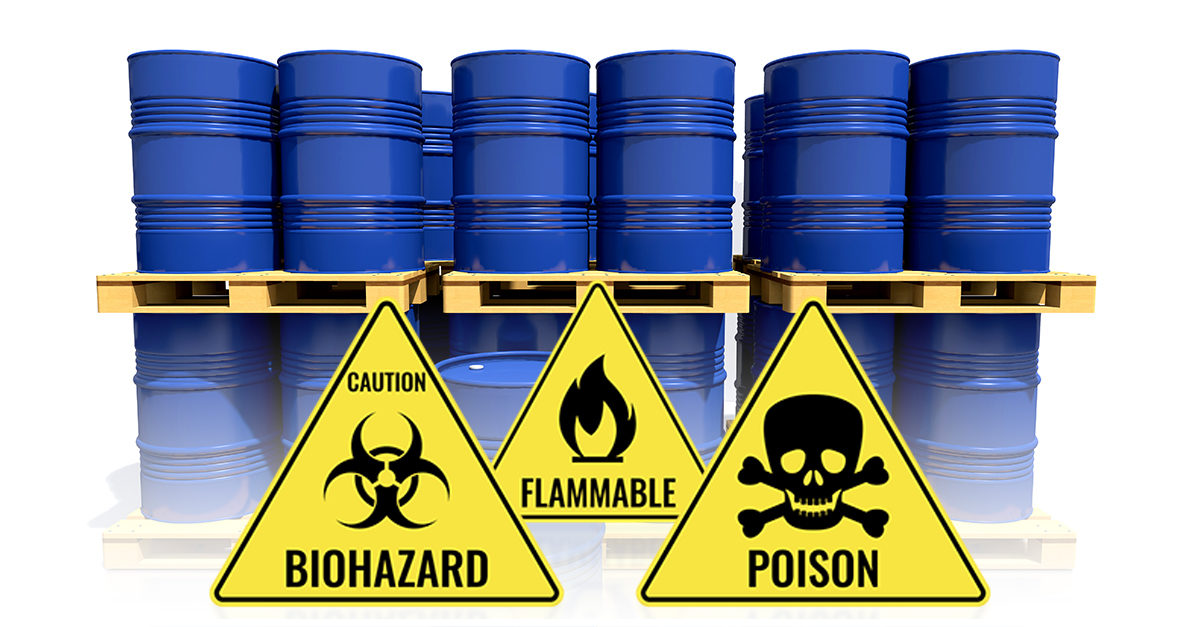When it comes to handling hazardous waste, it can be challenging to keep up with the ever-changing federal and state rules and regulations. For professionals responsible for the cleaning and upkeep of facilities, it is imperative to stay up to date on industry changes to ensure compliance and avoid potential fines and penalties.
Hazardous waste – which includes many cleaning items that commonly have corrosive characteristics – must be managed and disposed of properly, as inadequate waste management poses health and safety risks to people within a building, the community, and the environment. After all, it only takes one harmful incident to destroy the trust of the community.
Whether you work through a cleaning service provider or work as an in-house service provider, it’s important to take the necessary planning steps to ensure your hazardous waste is properly managed.
What is Hazardous Waste?
Before you make a plan of action, have a good understanding of what categorizes as hazardous waste. Hazardous waste is generally defined by the U.S. Environmental Protection Agency (EPA) as a chemical or product that no longer has an intended use and possesses substantial or potential threats to public health or the environment. It can come in many different forms, and may be a discarded chemical or an expired or damaged product.
To be considered hazardous waste, the item must exhibit ignitable, corrosive, reactive, and/or toxic characteristics. The item may also be on the EPA’s U, P, F, or K lists of hazardous wastes. While the immediate assumption for some cleaning professionals might be that they only handle cleaning and disinfection products, there are several different types of hazardous waste to be aware of when sorting and managing materials. For cleaning industry professionals, this may include any of the following:
- Cleaning products, such as floor care products, ammonia-based cleaners, kitchen and bathroom cleaners, etc.
- Flammables/solvents
- Pesticides, poisons, and other garden chemicals
- Aerosols (e.g. air fresheners, air dusters, paints, glue, etc.)
- Some toiletries
- Universal waste, such as light bulbs, florescent lamps, batteries, etc.
- Used oil and oil filters.
If you are unsure if a product is considered hazardous waste, review the safety data sheet (SDS), manufacturer’s information, labels, and ingredients, or refer to a hazardous waste materials training poster or guide.
Segregating Hazardous Waste
Not only are packaging guidelines and categorized accumulation bins critical to safely segregating hazardous waste, but they can help prevent future fines and penalties down the road. When accruing waste, incompatible items need to be separated; thus, it is recommended to designate and use separate bins for the different hazardous waste categories:
- Aerosols
- Flammables
- Toxics
- Corrosive acidic
- Corrosive basic
- Oxidizer
- Universal waste.
Preventing Leaks and Chemical Reactions
There are many ways to properly containerize or package hazardous waste items. One option is to store them in a bin and individually place items in sealed plastic bags. This will prevent items from mixing together and causing a reaction. Pay special attention to any leaking containers, as those should be double-bagged; absorbents should be added to avoid any issues.
Storage and Waste Management: Best Practices
Follow the below guidelines to safely store and manage the tracking of hazardous waste materials:
Label your bins. Once the first item is put inside an accumulation bin, label the container as “hazardous waste.” Be sure to write the accumulation start date, which is the date you placed the first item in the bin. Labeling is a vital step in the process, as it is one of the first things an inspector will examine during a routine check-in.
Maintain a log. While not required, it is a best practice to keep an inventory log to help manage and track waste generation amounts. Every time an item is identified as hazardous waste and placed into an accumulation bin, it should be noted on the log and kept in your records.Store bins in a low-traffic, risk-free area. Accumulation bins should be stored in a dedicated and permanent hazardous waste area. Ensure this dedicated area is far away from heavy traffic areas, electrical panels, or dock doors. While a small supply closet in a building might be the most convenient area, it does not mean that it is the best spot to store hazardous waste. Bins should be easily accessible, and labels need to be clear and visible. All other supplies, such as containment bags, spill kits, and absorbents, should also be located within this area.
Schedule weekly inspections. Depending on your generator status and your state’s regulations, weekly inspections of hazardous waste accumulation containers and storage areas may need to be performed by your staff. This helps confirm that materials are properly stored, and the area is properly maintained. Failure to do so could result in hefty fines and penalties.
Rope in a Professional
While cleaning services professionals should be knowledgeable and aware of hazardous waste regulations, hiring a hazardous waste management services provider can help alleviate some of the headache and stress of managing hazardous waste. Hiring a third-party provider can help to ensure you are not only properly handling and disposing of hazardous waste but staying within state and federal regulations.




